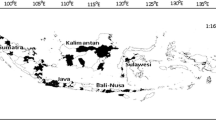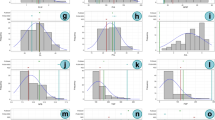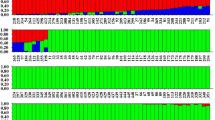Abstract
China is one of the largest centers of genetic diversity of Oryza sativa L. in the world. Using a genetically representative primary core collection of 3,024 rice landraces in China, we analyzed the genetic structure and intraspecific differentiation of O. sativa, and the directional evolution of SSR. The genetic structure was investigated by model-based structure analysis and construction of neighbor-joining phylogenetic tree. Comparison between genetic structure and predefined populations according to Ting’s taxonomic system revealed a hierarchical genetic structure: two distinct subspecies, each with three ecotypes and different numbers of geo-ecogroups within each ecotype. Two subspecies evidently resulted from adaptation to different environments. The different cropping systems imposed on the subspecies led to further differentiation, but the variation within each subspecies resulted from different causes. Indica, under tropical-like or lowland-like environments, exhibited clear differentiation among seasonal ecotypes, but not among soil-watery ecotypes; and japonica showed clear differences between soil water regime ecotypes, but not among seasonal ecotypes. Chinese cultivated rice took on evident directional evolution in microsatellite allele size at several aspects, such as subspecies and geographical populations. Japonica has smaller allele sizes than indica, and this may partly be the result of their different domestication times. Allele size was also negatively correlated with latitude and altitude, and this may be interpreted by different mutation rates, selection pressures, and population size effects under different environments and cropping systems.






Similar content being viewed by others
References
AGRTPR—a study group on the response to temperature and photoperiod of rice. (1978) Studies on the photoperiod and temperature ecology of rice cultivars in China. Science Press, Beijing, China, 154 pp (in Chinese)
Akagi H, Yokozeki Y, Nagaki A, Fujimura T (1997) Highly polymorphic microsatellites of rice consist of AT repeats and a classification of closely related cultivars with these microsatellite loci. Theor Appl Genet 94:61–67
Anderson JA, Churchill GA, Autrique JE, Tanksley SD, Sorrells ME (1993) Optimizing parental selection for genetic linkage maps. Genome 36:181–186
Banchs L, Bosch A, Guimera J, Lázaro C, Puig A, Estivill X (1994) New alleles at microsatellite loci in CEPH families mainly arise from somatic mutations in the lymphoblastold cell lines. Hum Mutat 3:365–372
Bleiweiss R (1998) Slow rate of molecular evolution in high-elevation humming birds. Proc Natl Acad Sci USA 95:612–616
Cai HW, Morishima H (2000) Diversity of rice varieties and cropping system in Bangladesh deepwater areas. Jpn Agric Res Q 34:221–226
Cheng KS, Lu YX, Luo J, Huang NW, Lin GR, Wang XK (1984a) Studies on indigenous rice in Yunnan and their utilization—the photo-thermo-response patterns of rices in Yunnan province and their relation to the classification of maturity roups. Acta Agron Sin 10(3):163–171
Cheng KS, Zhou JW, Lu YX, Huang NW, Wang XK (1984b) Studies on the indigenous rices in Yunnan and their utilization II. Revised classification of Asian cultivated rice. Acta Agron Sin 10:271–280
Cheng CY, Motohashi R, Tsuchimoto S, Fukuta Y, Ohtsubo H, Ohtsubo E (2003) Polyphyletic origin of cultivated rice: based on the interspersion pattern of SINEs. Mol Biol Evol 20:67–75
Cooper G, Burroughs NJ, Rand DA, Rubinsztein DC, Amos W (1999) Markov chain Monte Carlo analysis of human Y-chromosome microsatellites provides evidence of biased mutation. Proc Natl Acad Sci USA 96:11916–11921
Ellegren H (2004) Microsatellites: simple sequences with complex evolution. Nat Genet 5:435–445
Evanno G, Regnaut S, Goudet J (2005) Detecting the number of clusters of individuals using the software structure: a simulation study. Mol Ecol 14:2611–2620
Ewens WJ (1972) The sampling theory of selectively neutral alleles. Theor Popul Biol 3:87–112
Excoffier L, Laval G, Schneider S (2005) Arlequin ver. 3.0: an integrated software package for population genetics data analysis. Evol Bioinform Online 1:47–50
Falush D, Stephens M, Pritchard JK (2003) Inference of population structure using multilocus genotype data: linked loci and correlated allele frequencies. Genetics 164:1567–1587
Flessa KW, Jablonski D (1996) The geography of evolutionary turnover: a global analysis of extant bivalves. In: Jablonski D, Erwin DH, Lipps JH (eds) Evolutionary palaeobiology. University of Chicago Press, Chicago, pp 376–397
Gao LZ, Innan H (2008) Nonindependent domestication of the two rice subspecies, Oryza sativa ssp. indica and ssp. japonica, demonstrated by multilocus microsatellites. Genetics 179:965–976
Gao H, Williamson S, Bustamante CD (2007) An MCMC approach for joint inference of population structure and inbreeding rates from multi-locus genotype data. Genetics 176:1635–1651
Garris AJ, Tai TH, Coburn J, Kresovich S, McCouch S (2005) Genetic structure and diversity in Oryza sativa L. Genetics 169:1631–1638
Gillooly JF, Allen AP, West GB, Brown JH (2005) The rate of DNA evolution: effects of body size and temperature on the molecular clock. Proc Natl Acad Sci USA 102:140–145
Glaszmann JC (1987) Isozymes and classification of Asian rice varieties. Theor Appl Genet 74:21–30
Goldstein DB, Schlotterer C (1999) Microsatellites: evolution and applications. Oxford University Press, Oxford
Goudet J (2001) FSTAT, a program to estimate and test gene diversities and fixation indices (version 2.9.3). Available from http://www.unil.ch/izea/softwares/fstat.html
Hurlbert SH (1971) The nonconcept of species diversity: a critique and alternative parameters. Ecology 52:577–586
ICGRCAAS (Institute of Crop Germplasm Resources of China Academy of Agricultural Science) (1996) Catalogue of rice germplasm resources in China (1988–1993). China Agricultural Press, Beijing
Jablonski D (1993) The tropics as a source of evolutionary novelty through geological time. Nature 364:142–144
Kato S, Kosaka H, Hara S (1928) On the affinity of rice varieties as shown by the fertility of rice plants. Bull Sci Fac Agric Kyushu Univ 3:132–147
Khush G (1997) Origin, dispersal, cultivation and variation of rice. Plant Mol Biol 35:25–34
Kochko AD (1987) Isozyme variability of traditional rice in Africa. Theor Appl Genet 73:675–682
Konishi S, Izawa T, Lin SY, Ebana K, Fukuta Y, Sasaki T, Yano M (2006) An SNP caused loss of seed shattering during rice domestication. Science 312:1382–1396
Kovach MJ, Sweeney MT, McCouch SR (2007) New insights into the history of rice domestication. Trends Genet 23:578–587
Li ZC, Zhang HL, Cao YS, Qiu ZE, Wei XH, Tang SX, Yu P, Wang XK (2003) Studies on the sampling strategy for the primary core collection of Chinese ingenious rice. Acta Agron Sin 29:20–24
Li C, Zhou A, Sang T (2006) Rice domestication by reducing shattering. Science 311:1936–1939
Liu K, Muse S (2004) PowerMarker: new genetic data analysis software, version 2.7 (http://www.powermarker.net/)
Londo JP, Chiang YC, Hung KH, Chiang TY, Schaal BA (2006) Phylogeography of Asian wild rice, Oryza rufipogon, reveals multiple independent domestications of cultivated rice, Oryza sativa L. Proc Natl Acad Sci USA 103:9578–9583
Manly BFJ (1985) The statistics of natural selection. Chapman and Hall, London
Miller MP (1997) Tools for population genetic analyses (TFPGA) 1.3: a Windows program for the analysis of allozyme and molecular population genetic data
Nakagawa H, Yamagishi J, Miyamoto N, Motoyama M, Yano M, Nemoto K (2005) Flowering response of rice to photoperiod and temperature: a QTL analysis using a phenological model. Theor Appl Genet 110:778–786
Nei M (1987) Molecular evolutionary genetics. Columbia University Press, New York
Oka HI (1988) Origin of cultivated rice. Japan Science Society Press, Tokyo
Oka HI (1992) Ecology of wild rice planted in Taiwan III. Differences in regenerating strategies among genetic stocks. Bot Bull Acad Sin 33:133–140
Panaud O, Chen X, McCouch SR (1996) Development of microsatellite markers and characterization of simple sequence length polymorphism (SSLP) in rice (Oryza sativa L.). Mol Gen Genet 252:597–607
Primmer CR, Ellegren H, Saino N, Moller AP (1996) Directional evolution in germline microsatellite mutations. Nat Genet 13:391–393
Pritchard JK, Stephens M, Donnelly P (2000) Inference of population structure using multilocus genotype data. Genetics 155:945–959
Rohlf F (1997) NTSYS-pc: numerical taxonomy and multivariate analysis system, version 2.00. Exeter Software, Setauket, New York
Rosenberg NA (2002) Distruct: a program for the graphical display of structure results. (http://www.cmb.usc.edu/~noahr/distruct.html)
Rubinsztein DC, Amos W, Leggo J, Goodburn S, Jain S, Li SH, Margolis RL, Ross CA, Ferguson-Smith MA (1995) Microsatellite evolution—evidence for directionality and variation in rate between species. Nat Genet 10:337–343
Saitou N, Nei M (1987) The neighbor-joining method: a new method for reconstructing phylogenetic trees. Mol Biol Evol 4:406–425
Sano R, Morishima H (1992) Indica-japonica differentiation of rice cultivars viewed from the variation in key characters and isozymes with special reference to land races from the Himalayan hilly areas. Theor Appl Genet 84:266–274
Second G (1982) Origin of the genic diversity of cultivated rice (Oryza spp.): study of the polymorphism scored at 40 isozyme loci. Jpn J Genet 57:25–57
Sokal RR (1979) Testing statistical significance of geographic variation patterns. Syst Zool 28:227–232
Stehli FG, Douglas DG, Newell ND (1969) Generation and maintenance of gradients of taxonomic diversity. Science 164:947–949
Sweeney MT, Thomson MJ, Cho YG, Park YJ, Williamson SH, Bustamante CD et al (2007) Global dissemination of a single mutation conferring white pericarp in rice. PLoS Genet 3:1418–1424
Takezaki N, Nei M (1996) Genetic distances and reconstruction of phylogenetic trees from microsatellite DNA. Genetics 144:389–399
Tam SM, Mhiri C, Vogelaar A, Kerkveld M, Pearce SR, Grandbastien M (2005) Comparative analyses of genetic diversities within tomato and pepper collections detected by retrotransposon-based SSAP, AFLP and SSR. Theor Appl Genet 110:819–831
Ting Y (1957) The origin and evolution of cultivated rice in China. Acta Agron Sin 8:243–260
Udupa SM, Baum M (2001) High mutation rate and mutational bias at (TAA)n microsatellite loci in chickpea (Cicer arietinum L.). Mol Gen Genet 265:1097–1103
Vergara BS, Chang TT (1985) The flowering response of the rice plant to photoperiod, 4th edn. IRRI, Los Banos, Philippines, p 61
Vigouroux Y, Matsuoka Y, Doebley J (2003) Directional evolution for microsatellite size in maize. Mol Biol Evol 20:1480–1483
Wang MX, Zhang HL, Zhang DL, Qi YW, Fan ZL, Li DY, Pan DJ, Cao YS, Qiu ZE, Yu P, Yang QW, Wang XK, Li ZC (2008) Genetic structure of Oryza rufipogon Griff. in China. Heredity (http://www.nature.com/hdy/journal/vaop/ncurrent/full/hdy200861a.html)
Waples RS, Do C (2008) LDNE: a program for estimating effective population size from data on linkage disequilibrium. Mol Ecol Res 8:753–756
Watterson GA (1978) The homozygosity test of neutrality. Genetics 88:405–417
Weber J, Wang C (1993) Mutation of short tandem repeats. Hum Mol Genet 8:1123–1128
Weir BS, Cockerham CC (1984) Estimation F-statistics for the analysis of population structure. Evolution 38:1358–1370
Xie ZW, Lu YQ, Ge S, Hong DY, Li FZ (2001) Clonality in wild rice (Oryza rufipogon, Poaceae) and its implications for conservation management. Am J Bot 88:1058–1064
Xu XH, Wang GC, Zheng XB, Wang HX (1974) A report on the vertical distribution of the rice varieties in Simao, Yunnan. Acta Bot Sin 16:208–222
Yeh FC, Yang RC, Boyle T (1999) PopGene version 1.31, Microsoft Window-based freeware for population genetic analysis. http://www.ualberta.ca/~fyeh/
Zeven AC (1998) Landraces: a review of definitions and classifications. Euphytica 104:127–139
Zhang DL, Zhang HL, Wei XH, Qi YW, Wang MX, Sun JL, Ding L, Tang SX, Qiu ZE, Cao YS, Wang XK, Li ZC (2007a) Genetic structure and diversity of Oryza sativa L. in Guizhou, China. Chin Sci Bull 52:343–351
Zhang HL, Sun JL, Wang MX, Liao DQ, Zeng YW, Shen SQ, Yu P, Wang XK, Li ZC (2007b) Genetic structure and phylogeography of rice landraces in Yunnan, China revealed by SSR. Genome 50:72–83
Acknowledgments
We thank Professor Robert A McIntosh, University of Sydney, for suggested revisions to the manuscript. This research was supported by the National Basic Research Program of China (“973” Program, 2004CB117201), Program for Changjiang Scholars and Innovative Research Team in University, and Program of Introducing Talents of Discipline to Universities (111-2-03).
Author information
Authors and Affiliations
Corresponding authors
Additional information
Communicated by J. Yu.
Electronic supplementary material
Below is the link to the electronic supplementary material.
Rights and permissions
About this article
Cite this article
Zhang, D., Zhang, H., Wang, M. et al. Genetic structure and differentiation of Oryza sativa L. in China revealed by microsatellites. Theor Appl Genet 119, 1105–1117 (2009). https://doi.org/10.1007/s00122-009-1112-4
Received:
Accepted:
Published:
Issue Date:
DOI: https://doi.org/10.1007/s00122-009-1112-4




